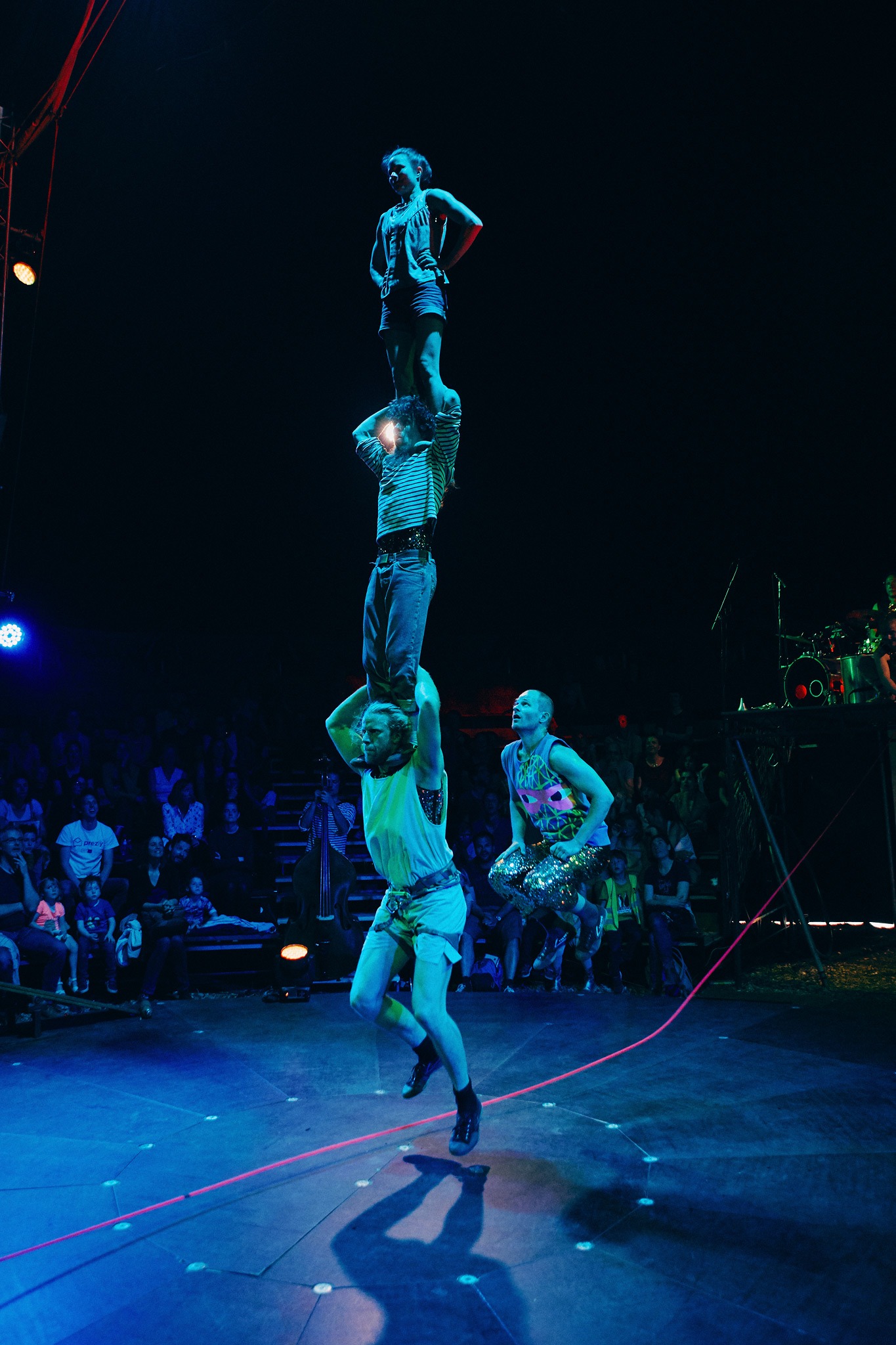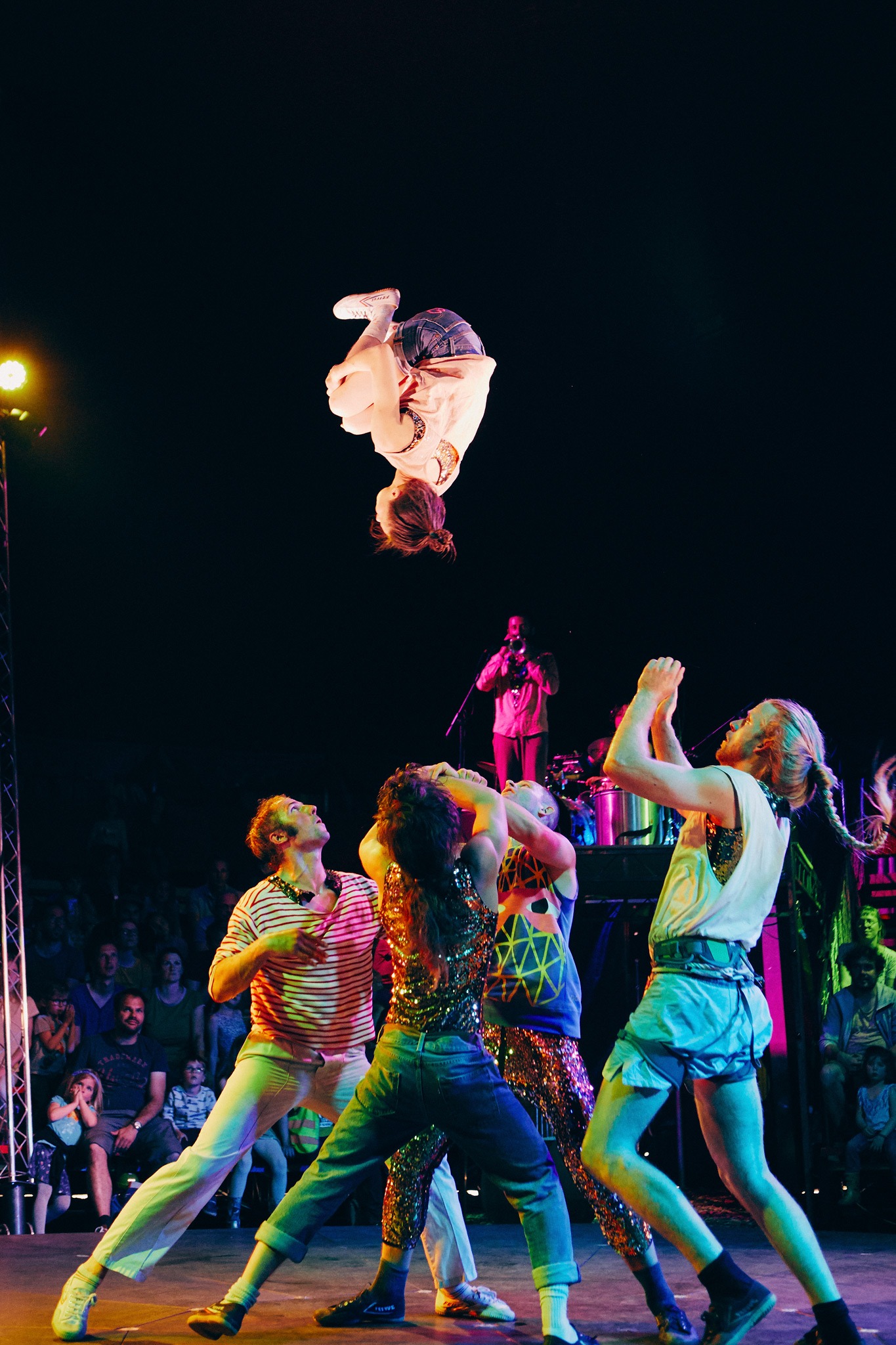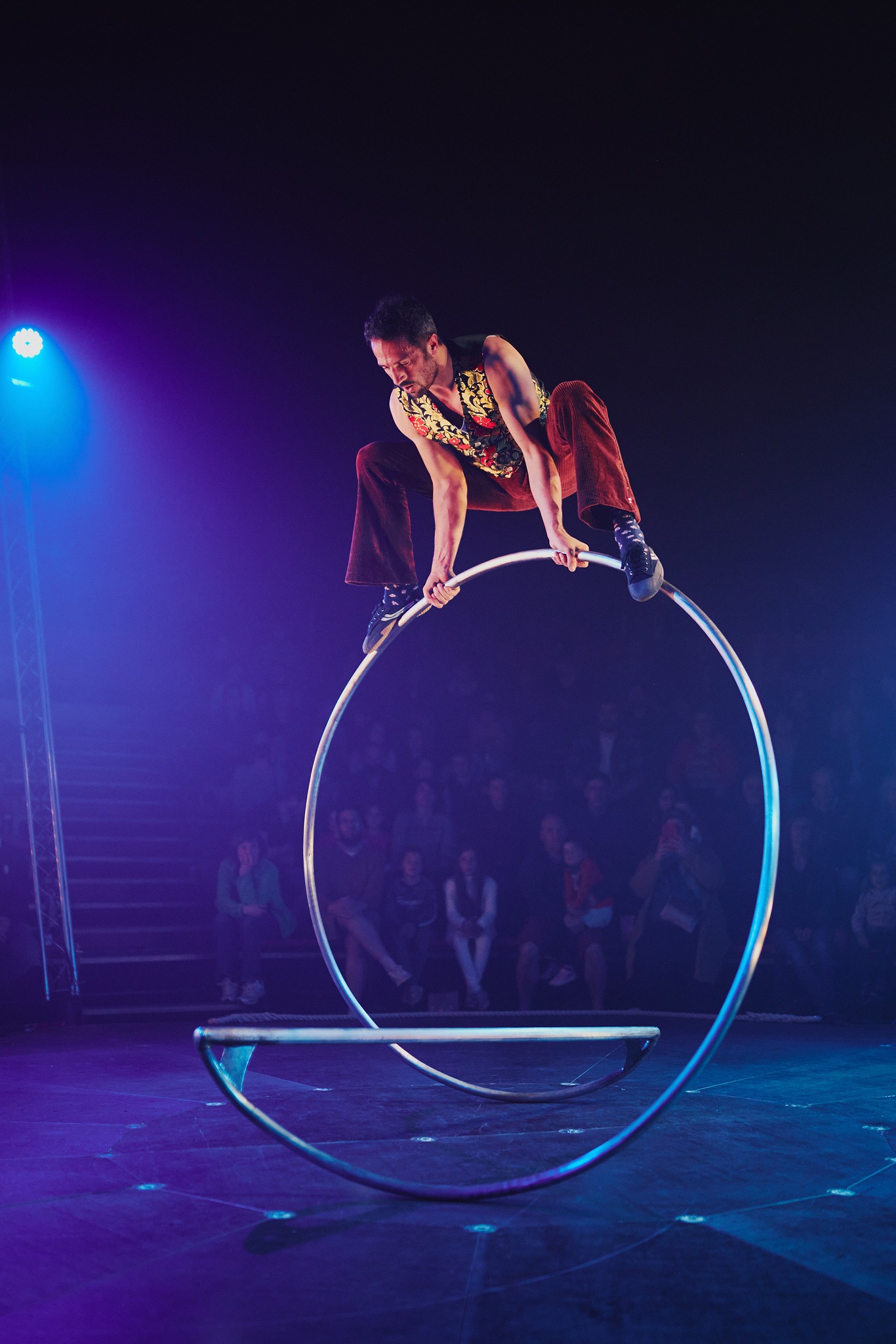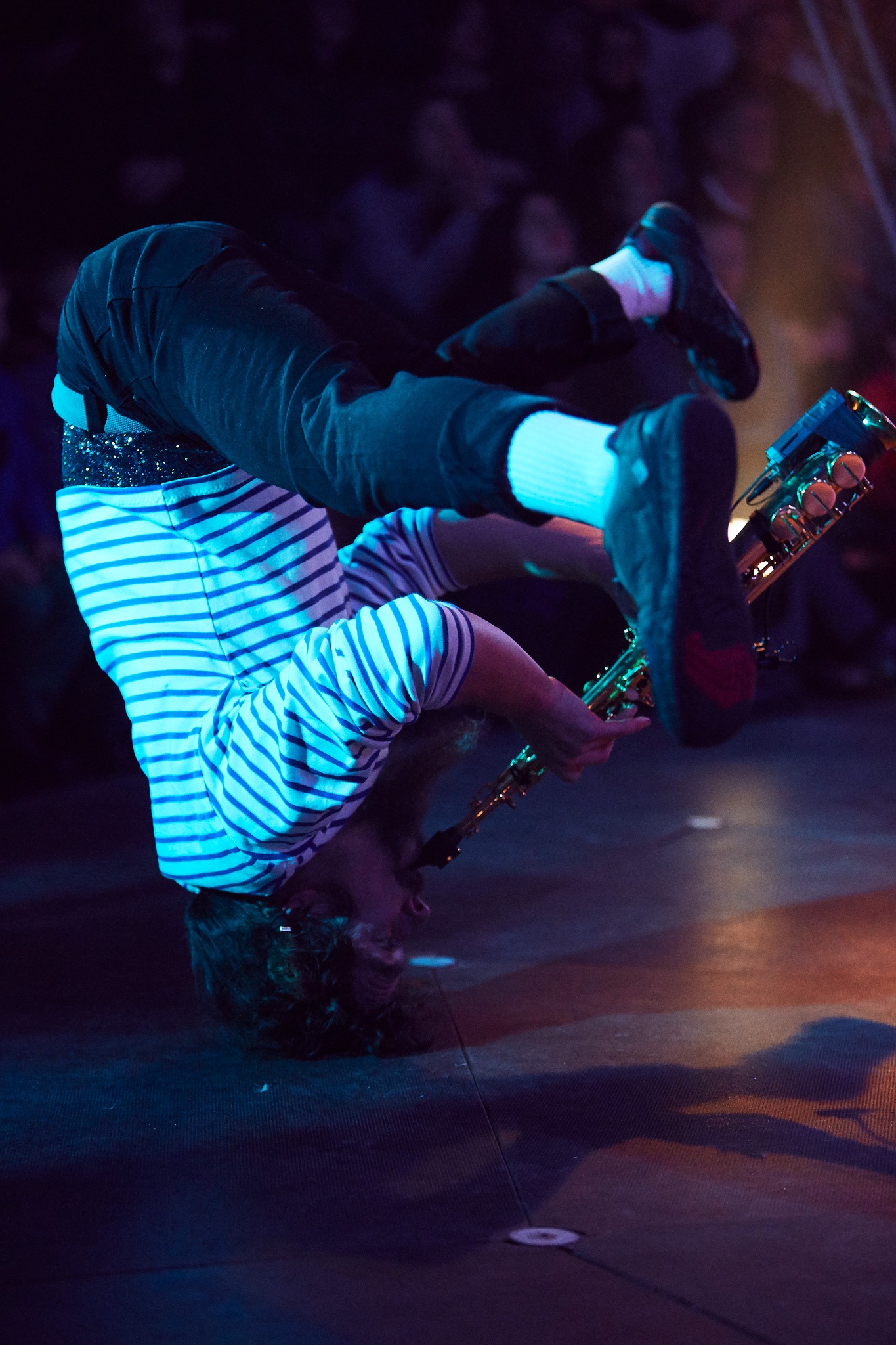About us
Circus I love you - an introduction
The core artistic question of the company is: What is left of the circus once we take it away from its traditional context and away from the influence of the other art forms?
Circus I love you aims to create performances that generate enthusiasm towards taking action in it audiences. The company values the artisan approach to circus, and pays respect to the patience-demanding approach that learning high level acrobatic skills requires. Circus I love you describes itself as a modern circus, wanting the people entering the tent to feel welcome and interested, experience embodied emotions while watching the acrobats and witness a modern set of values communicated through the actions presented on stage.
Circus I love you has been founded by acrobats to create circus performances

History and vision

Circus I love you - since 2017
In the spring of 2016, Sade Kamppila and Julien Auger decide to start Circus I love you from their common. They called their dream team, presented the plan to them, and organised together a set of “wild residencies”. The team of 8 gathered 4 times for two weeks within one year in Sweden, France, Denmark and Finland.. The schedule was simple : playing music together in the morning, training circus together in the afternoon. For the rest of the year Sade and Julien led the office work, bought the equipment, learned to drive trucks and brought in some help for the administration, production and technique of the project.
The first circus tent of the company was a second hand pink and yellow beauty found in Italy from Wanda Circus. She had been gifted this tent as a welcome from her community for saving the local economy by saving a local parmiggiano reggiano factory by selling cheese while street performing. Wanda’s tents story was one of care, dedication and physical involvement, that Circus I love you was inspired to carry on.
Circus I love you came to meet the audience for the first time in January 2018 by presenting a work in progress of the first creation at the festival Wintervuur (Antwerpen). On that day, the plan for the creation and the first tour was quite set. Summer 2018 was the first tour for Circus I love you, travelling from France to Lithuania and Sweden.
To answer the demand of the industry, Circus I love you invested in a larger, 500-seated circus tent in 2019. The gradin of the tent was built by the acrobats of the company, and In 2019 the company toured in The Netherlands, Belgium and France. As everything was taking off well, the crash into the pandemic reaity of 2020 was very harsh as Circus I love you had over 100 performances cancelled.
To not stay idle during the times performing was made impossible, Circus I love you advanced in the plan of touring also in the Nordic countries by investing in a small circus tent for 150 people. Utopia -performance, a small version inspired by Circus I love you was created in spring 2021, when it was not very clear if the performance would ever get to meet an audience. Finally 2021 proved to be a new start for Circus I love you, and the two shows were seen in Sweden, France, Germany and Belgium. In 2022 two new creations were created. I love you two was the second large creation for the big tent, and Beauties the second creation for the small tent touring in the Nordic countries. The four shows toured France, Belgium, Sweden and Finland all throughout March to October 2022.
The vision of Circus I love you
An acrobatic composition
Circus I love you creates circus performances that aim to compose with acrobatics in the same manner that music is composed with notes, chords and rhythms. The performances are not telling a narrative story, they don’t exactly “make sense”, yet they create an emotional journey for and with the audience. The acrobatic composition is done simultaneously with the musical composition to enforce this emotional journey. Thus the acrobatics and the music nourish each other, as different elements would do for example in a ballet.
It is more and more common to speak about dramaturgy when analysing a circus performance. In this I see a sort of colonialism arriving from the theatre world, often shared by circus artists themselves in lack of recognising the independence of their art form. I think that circus has a lot more in common with music than with theatre, and it would be a shame to limit ourselves just because of abusive use of vocabulary. Dramaturgy exists both in our performance Circus I love you as well as in a concert of Toy Dolls, but analysing it misses the point.
Julien Auger


What is left of circus once we take it away from a traditional context and from the other art forms ? In what way is this result beneficial for our society ?
Proudly just another circus
The world did not wait for Circus I love you to exist, and the tickets of all the other circuses were not sold out to a point that it was necessary to create yet another new one. Despite this, art is not supposed to only answer to a statistic demand. The circus responds to a need within the society. We see death every day on our screens. At the same time death, and even old age, is considered something bad that should not happen. Because of this it is necessary to propose more space in the society to break the taboos around these subjects. And what could do this better than circus? For Circus I love you these questions are at the core of the performances. For us to be heard our performance needs to be transcendental, poetic and moving.
So Circus I love you is an innovative, unique circus, living on the edge of society and animated by ideals, pretty much like every other circus, be it contemporary, traditional, or other. All these circuses bring together into reality an alternative to the virtualisation of society, a positive image of marginality, and respect for the human body and embracing its animality.
Tension towards failure has been a big focus in circus performances throughout the history of circus. An audience gathering to witness the acrobat performing life threatening acrobatics works as a possibility to put the lives of people into greater perspective. We as humans do not know what we are doing on earth, or why we are here. The acrobats with their actions are pointing out the absurdity of our existence. The fear of failure prevents people from trying. The fear of the unknown prevents people from initiating adventures. The fear of being judged prevents people from demonstrating what they believe is important. All kinds of fears people learn throughout their lives make them docile and rely on consuming more than they need. The work acrobats do with taking responsibility, risk analysis and management on the physical and mental level is a great example of how fear can be broken down into pieces easier to swallow. In the context of circus the process often results in an impressive stunt that can be witnessed by an audience, but the deeper message transmitted through the action is a method that can be applied in other areas of life as well.
Sade Kamppila
The circle
The circular performance space is encouraging a different relation between the performer and the spectator. Circus means circle in Latin. From the origin, circus was defining a space for a performance, not the content of the performance. In thousands of years of history, circus has been performed in a circular space surrounded by the audience. Nowadays, new circus is mainly played in theatre and dance venues, because this is the existing space circus has been given to perform in. However, the circular performance space itself has made circus arts evolve through demonstrating certain action and subjects. Kamppila and Auger consider that performing in a circle is one of the essential qualities remaining of circus arts once the traditional context and influence of other art forms is taken away. Performing in a circle creates the effect that the person performing can not hide anything nor be hidden.


Showing reality
Not hiding is the major quality of the circus performer. The performer can not pretend to be or to do anything else than what is happening. Performing in a circle also means that the background scenography of the actions is made up by the other part of the audience. This reinforces the concreteness of the actions of the performer. No diegesis is possible in a circus space. If we conclude that circus is showing reality, next comes the question of why is a performance space for showing reality necessary? Reality is everywhere around us. Why should one come in a special space to look at it?
Death, failure and absurdity
The content of circus, what circus shows, has to be special. It has to tell about what is rarely told. High stakes bring people together, they are the reason for a show. A theatre play can be for example a love story or a war story, but there has to be something at stake for the performance to be relevant in the eyes of the audience. If circus can not fake high stakes, it can make it happen for real. This is why the tension towards failure has been in a big focus in circus performances throughout the history of circus. The tension towards failure is sometimes just about pride (e.g a juggler dropping an object), but also more often about life or death (the acrobat performing a physical stunt). On one hand, a crowd gathering to witness an acrobat performing life threatening acrobatics is an indication of the unhealthy relationship that people have towards death in the society we live in. On the other hand, it also works as a possibility to put the lives of people into greater perspective. The acrobat is a Joker, who is asking the audience if their worries are actually so important.


The love
The thoughts and attempts of defining circus has led Kamppila and Auger into defining what would be the future development for it. If circus can be a tool for making people reflect on their life through experiencing high stakes, and if the quality of the high stakes performed is chosen by an artist spotting the need in the society for it, then the next high stake that needs to be displayed on stage is love. The love should not be acted, the audience does not need to understand it. It has to be present and shown, and the audience will feel it.
The travel
In creating circus arts the focus is very often in developing a physical skill through a long and slow learning process. This brings lengthy creation times, and makes it physically and mentally hard for the artist to recommence the process after the performance has been premiered. For circus arts, it makes more sense to travel displaying the same performance for always a new audience, rather than to keep on creating new performances for the same audience. The nomad lifestyle of the circus is an answer to how to keep on fulfilling its mission without having the capacity to generate completely new material every month. It is for these reasons that the company Circus I love you states for creations in circus tents. By having an own mobile venue, Circus I love you has a mean by which to reach new audiences, a space welcoming artistic research, and proposition of a new action model for Nordic new circus.


Combining music with circus
While the company has a strong focus on questioning and aiming to reach a “pure” practice of circus, they realise that within the context of where circus arts is today, combining circus with music will help to reach the current audiences. The artistic directors find many similarities and parallels in the practices of music and circus arts. Both carry a long learning process to master the discipline. Both work with the body as well as with objects or instruments outside the body to produce an effect. Both communicate emotions, energies, ideas and information wordlessly, and have thus a possibility to communicate to a wide international audience. Both arts provide an easy access for enjoying the performance, whether the audience member is a first timer to a performance or an experienced culture consumer. On the journey of researching the essence of circus through performance, the team feels like music provides us with an adaptable ladder for the audience to enjoy and relate to the performances.
“Open source" art on stage
Circus I love you claims to be part of the free art movement. In order for more people to have access to culture, it needs to be proposed in a way that it’s accessible on the practical as well as on the economical level. With this perspective, Circus I love you questions the concept of copyright in the context of circus (contemporary or not). Circus is an art form in which it’s not possible for an author to dictate a partition of acrobatics for the acrobat, unless the acrobat takes part in creating the partition based on their individual acrobatic vocabulary. This process is nevertheless often attempted, specially in cases where the aim is to replace an acrobat in a performance. The result is either a failure (the acrobatic partition changes in the process) or dangerous (the classic case where the replacing acrobat becomes injured). If every acrobat, replacing or not, is participating in the creation of the partition, what is the sense in dissociating the work of the author and the work of the acrobat, and for what good should a creation be “protected” if it’s dangerous to reproduce it?
The concept of authorship in circus seems justified in the case that the author works on the creation of the show not concerning the acrobatic content. Circus I love you wants precisely to develop the acrobatic creation. Thus the acrobats who are employed are all authors of the work created and accepting that the performance created is finally free of rights.
I want to encourage unconditional sharing in order to develop our society. If we create a performance, it’s because we want it to be seen. And if we want it to be seen, why prevent others from copying it, or building on top of what we have built?
Julien Auger

On the practical level, the creations of Circus I love you are declared copyleft. “Copyleft: This is a free work, you can copy, distribute, and modify it under the terms of the Free Art License http://artlibre.org/licence/lal/en/
Circus I love you has created 4 performances.
I love you two is the second love declaration to circus created by Circus I love you. It is a triptyque of duo performances accompanied by a live orchestra.
Circus I love you is an utopian circus. It is an ongoing cross-composition of acrobatics and live music that takes inspiration from long musical pieces.
Newest creation of Circus I love you touring the Nordic countries.
An acrobatic and musical composition touring the Nordic countries.